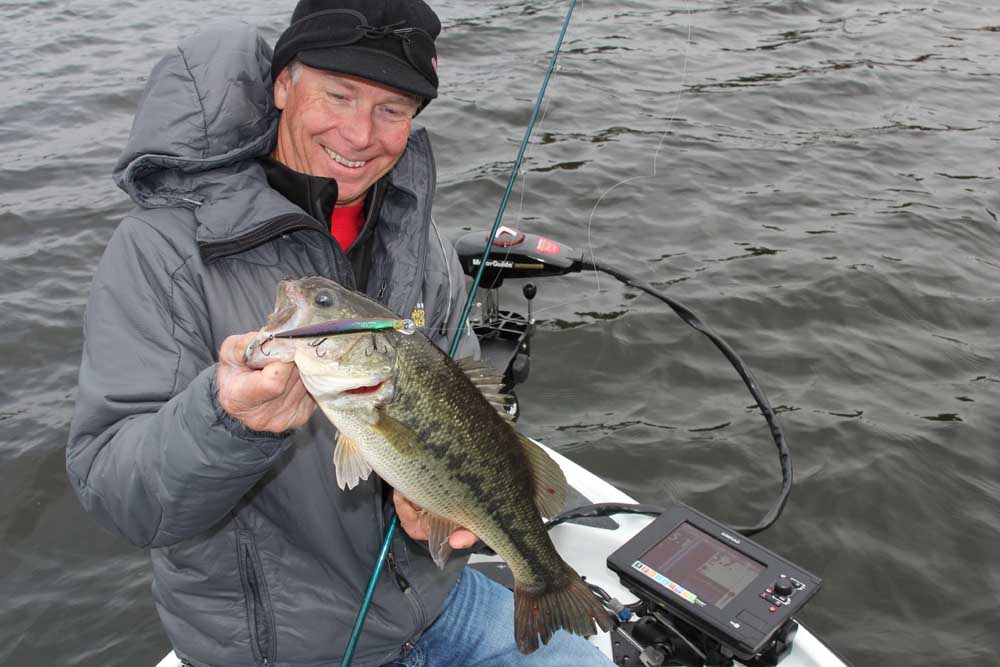
There may not be a more effective lure than a jerkbait for catching bass in cold water.
“You’ll find one tied on my rod just about any time the water temperature is in the 50s or lower,” said Arkansas Elite pro Kevin Short.
Jerkbaits can be effective in any manner you wish to fish them, but cold-water tactics require a more refined approach, he added.
Here are Short’s tips to being a more efficient jerkbait angler when the water gets cold:
Lighten up your tackle
Many anglers try fishing jerkbaits with tackle that’s too heavy. Short prefers a 6 1/2-foot or 6-foor, 8-inch rod (St. Croix Legend Supreme) with medium power and an extra fast action. Because he works his rod pointed downward, the shorter rod prevents the tip from hitting the water. The softer action keeps him from losing fish.
“Oftentimes in really cold water, the fish don’t eat the bait; they slap at it and get hooked alongside the head,” Short explained. “With a softer rod that has some flex, the hooks are less likely to pull out when you get a fish next to the boat.”
He pairs the rod with 8- to 12-pound Vicious Pro Elite Fluorocarbon and a Lew’s Tournament Pro baitcaster.
“I use a lot of monofilament in the spring when the water temperature is in the 50s and I don’t want the bait to sink,” he added. “But when it’s colder than that, I use fluorocarbon because I want the bait to suspend or sink a little.”
Experiment with lures
Most anglers stay with the same bait all day when the fish are biting it. Short, who fishes a lot of local winter tournaments around his Arkansas home, will start with a smaller bait then switch to a larger one.
“I fish a lot of Megabass 110 jerkbaits that are about 5 1/4 inches long,” he described. “I’ll catch a limit on that then switch to the same color in the 110 Magnum size that is about inch longer and thicker, giving a bigger profile.”
The Magnum jerks to the same depth, and while it doesn’t draw as many bites, it does attract bigger fish.
“I’ve seen it work the other way, too, especially in clear water,” Short adds. “Downsizing may get you more bites when they aren’t hitting the medium size.”
Play with retrieve
The retrieve cadence and the angle at which the bait sits in the water, especially with suspending baits in clear water, can be critical.

“I’ve seen a long pause or the amount of time between jerks do as much to trigger a fish as how you’re twitching it,” Short offered. “That’s something easy to play with; cast it out and let it sit, twitch it real soft a couple of times then let it sit momentarily. The next time, let it sit longer and then twitch it real hard and let it sit again. Just remember exactly what you were doing when you caught the first fish.”
Short is convinced that the angle the bait sits in the water — which can be affected by the hooks — can be a factor, too.
“If you want the nose to dive steeper, put a heavier hook on the front hanger, wrap lead wire around the hook shaft or put a lighter hook on the back of the bait,” he described.
If you want the bait to sit with the nose higher, change to the same size of monofilament that you were using with fluorocarbon.
“The fluorocarbon can pull the bait down,” Short adds. “That can be good when shad die and fall to the bottom. However, before they die they may swim with their heads up. Pay attention to what’s going on around you.”





